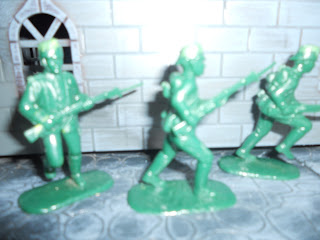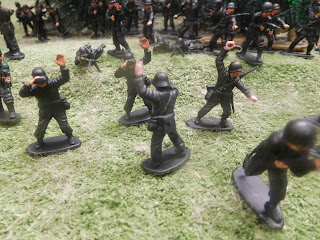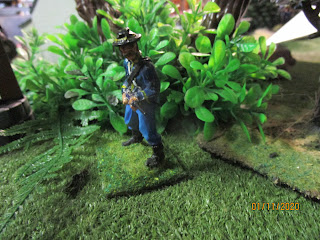My British (& Beersteiner) Miter Cap Guardsmen
I finally have a full regiment of my Miter Cap British guardsmen. I am not going to claim which regiment it represents. Much of the intricate decorative detail varies, by sometimes tiny amounts yet with two regiments having the same facing colors. The officer here I painted once with a different reference, so he is really from a different regiment. I'll either repaint his cap or find another figure. I have painted the drummer boy in reverse colors; I gather this was not always done but it looks interesting.
The regiment started off as all Charbens figures and conversions of the same. To complete the unit, I did a number of conversions of other brands. As I added to the unit over a number of years the poses are as hodgepodge; normally I would have all shooting, advancing, marching or picking noses.
The British grenadiers had their headgear changed from miter caps to bearskins for the American Revolution. They would be fine for the French and Indian War. The Hessians still had miter caps when they served in the Revolutionary War and I'll show my unit of those, and also Swiss grenadiers, in a future post.
With a change of flag these boys will also be my 3rd Beersteiner grenadiers.












Great job James - I am a huge fan of Grenadiers!
ReplyDeleteThanks Paul.
ReplyDeleteYour grenadiers looks great. I really like these colorful uniforms!
ReplyDeleteWhen you mention that these miniatures is a full 'Regiment' I guess they're not 1:1 representation, and perhaps each figure represents ab smaller unit like battalion and compagnie?? A regiment is thousands of men, and consists of several battalions of hundreds. A battalion is several compagnies of more than 100 soldiers each.
Anyway, they're nice painted and are looking good. I usually don't paint 'eyes' but yours looks good with.
I have a thing about painting eyes! a lot of people don't because, they say, you wouldn't see the eyes in real life because the figure, at its size represents someone 50 or so meters away! (The less charitable explanation is it is too hard to paint the eyes!)
DeleteWell, I am at tabletop level, looking at my toy soldiers and they are not 50 meters away; they are 20 centimeters away!
Both sides have a case to make. A 'flesh wash'; settles in the eye socket area and is a compromise. I can see that a reasonable solution especially for smaller scales.
When I was a teenager I studied 'model soldier' books from the school library and taught myself a system for painting eyes. I add a dash of light blue to the eyeball color and next paint blue, grey, green or brown irises ( I used to also paint the pupils, but these days consider that unnecessary). Then I use red brown to paint lines under and over or sometimes just over the top of the eyes, closing the size of the area. Lastly, I edge up the flesh color to the eyes. his avoids the 'zombie' or 'pop-eye' look.
The main thing is to have a quality fine brush with a point. I go through quite a few.
That is a good point, Roger!
ReplyDeleteIt is a common wargame representation to have a much smaller number of figures to represent larger units. The reason originally, was probably to more easily represent historical battles like Waterloo where having the actual 1:1 would be impractical and even impossible.
More to the point, at least to me, is I like to have a range of uniforms in the battles. On the other hand, as I have character figures that obviously represent one man (or woman) the system is illogical but something I don't sweat over.
I also never bothered with the system where when a casualty occurs one writes it down somehow, without removing a figure because, well, one figure represents 100 or 1000 and a figure is not removed until 10 or so casualties occur.
The only time it is not a theoretical issue is if I play a skirmish game where big units are not represented.
I also don't bother that much with complicated calculations of scale as to how much area figures occupy.
When it comes to buildings and ground, I could say (vaguely) that one building actually represents several, a map hex represents a number of hexes, and so on.
Getting back to a real regiment, it is not always full strength or entirely present on a battlefield, but yes, I am aware that 24 men is a long way removed from several hundred! As a way of masking this discrepancy I could say 'unit' instead of regiment. However, when, in my campaign, a unit is wiped out that is the end of that 'regiment'. For that reason, there is a motivation to withdraw the remnants from the field, rather than fighting to the last toy soldier, so a portion of casualties can be restored to the 'regiment' and it can fight another day.
Basically, what I do is represent, to some degree, the historical aspects of comparative weapon ranges and effectiveness, tactics and uniforms whilst largely glossing over the numbers.
The other thing is I usually don't represent the civilians, other than a few dotted here and there. Also, the dead and mangled bodies of the toy soldiers are neatly removed! When I do, at least the former, it is a special scenario of refugees clogging roads when they flee or even taking up arms against invaders, or, in some cases, everyone who intrudes on their land.